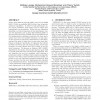300 search results - page 13 / 60 » Designing a Practical Access Point Association Protocol |
WISEC
2010
ACM
14 years 2 months ago
2010
ACM
Determining whether a client station should trust an access point is a known problem in wireless security. Traditional approaches to solving this problem resort to cryptography. B...
MSWIM
2005
ACM
14 years 1 months ago
2005
ACM
While the canonical behavior of today’s home Internet users involves several residents concurrently executing diverse Internet applications, the most common home configuration ...
TIT
2010
13 years 2 months ago
2010
We study cellular-like wireless networks in which the cells may overlap substantially, and a common channel is used for all cells. Thus, transmissions intended for one destination ...
WWW
2010
ACM
13 years 6 months ago
2010
ACM
Semantic Web applications take off is being slower than expected, at least with respect to “real-world” applications and users. One of the main reasons for this lack of adoptio...
MSWIM
2004
ACM
14 years 1 months ago
2004
ACM
Today, three different physical (PHY) layers for the IEEE 802.11 WLAN are available (802.11a/b/g); they all provide multi-rate capabilities. To achieve a high performance under v...

